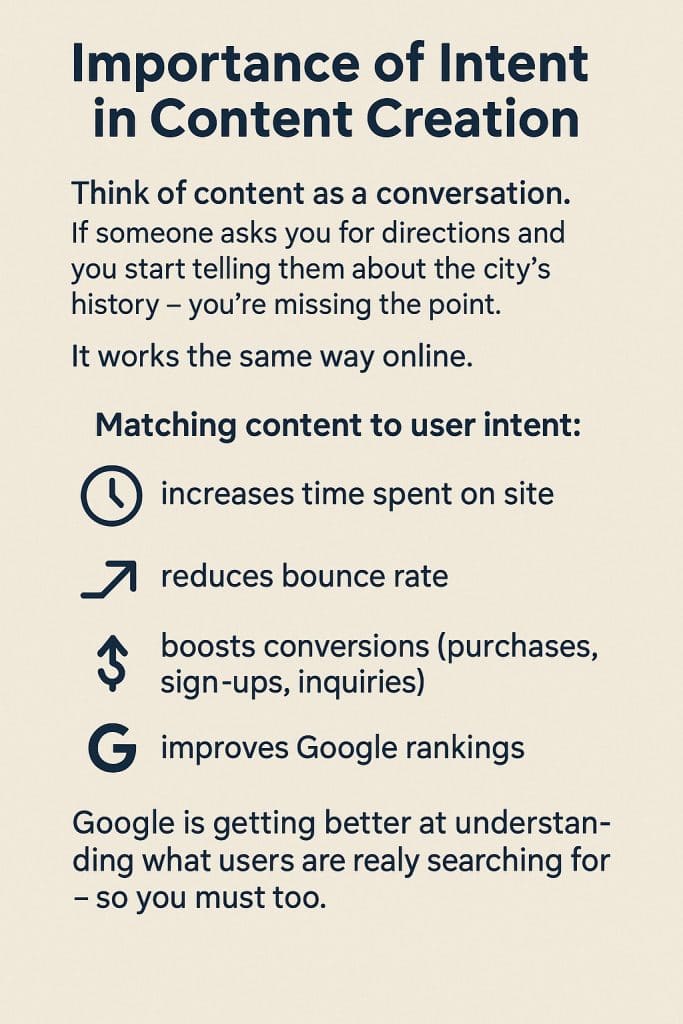Content Map for Customer Intent: Intent Mapping Guide
Imagine you’ve just opened a café in the city center. You have great coffee, a cozy interior, and friendly staff. But there’s a problem – no one shows up. Why? Because no one knows you exist. And even if someone stumbles upon your website… they quickly leave. What went wrong?
You probably didn’t understand what your potential customers are looking for – you didn’t map their intent. In content marketing, this is one of the most important elements that determines success. Today I’ll tell you what a user intent map is, how to create it, how to use AI and keywords, and how to measure the effectiveness of this approach.
Understanding Customer Intent.
Defining Customer Intent.
User intent (also known as search intent) is the actual goal behind someone entering a query on Google, visiting your site, or clicking a newsletter. It’s not just what they type – but why they’re doing it.
Imagine two people searching for “best coffee in Warsaw.”
The first one is looking for reviews and rankings – they want to learn something.
The second one is looking for a nearby place to go – they want to take action.
Same phrase, two totally different intents.
Types of user intent.
SEO and UX experts typically distinguish four main types:
Informational.
The user wants to learn something.
Example: “how to brew pour-over coffee”
Navigational.
They are looking for a specific website or brand.
Example: “Nespresso contact”.
Transactional.
They are ready to buy or take action.
Example: “buy Philips 3200 coffee machine”
Commercial investigation.
They are comparing products, reading reviews.
Example: “coffee machine rankings 2025”.
Understanding which type you’re dealing with is key to creating content that keeps users engaged.
Importance of Intent in Content Creation.

Creating an Intent Map.
Steps to Build an Intent Map.
Creating an intent map helps you connect keywords, content, and your audience’s goals.
Here’s how to do it:
- Gather audience data.Who are your users? What problems, questions, and needs do they have?
Which sites do they visit most often?
What questions do they ask on Google, chats, or contact forms? - Create a keyword list.
Use tools like Google Search Console, Ahrefs, SEMrush, Ubersuggest, or Neuronwriter. Focus not just on high-volume terms, but also on long tail keywords, e.g., “is coffee from a pressure machine healthy?” - .Define the intent behind each phrase
For each keyword, ask: what does this person really want to know?
Examples:
“best coffee for the office” → commercial
“arabica coffee history” → informational
“book café for event” → transactional
- Match keywords to specific content.
You create a content grid – each blog post, article, product page, or FAQ addresses a specific intent. You can build a table with columns: keyword, intent, format, link. - Identify gaps and opportunities
Maybe you have lots of informational content but nothing transactional. Now you know what to add.
AI and Intent Mapping.
How can AI help with intent mapping?
Artificial intelligence opens up new possibilities for analyzing customer intent. Instead of relying only on intuition and basic tools, you can now:
Analyze large datasets
AI can analyze thousands of user queries, social media comments, and product reviews, identifying patterns and hidden intents that humans might miss.
Predict trends
AI models can anticipate which intents will be popular in the near future, enabling proactive content creation.
Personalize in real time
AI can tailor content to individual user intent based on their on-site behavior, browsing history, or demographic profile.
An example of effective AI use is Netflix, which analyzes user behavior to predict what movies they’ll like – and adjusts the interface and recommendations accordingly.
Which AI models are used for intent analysis?
In practice, many SEO and content tools (NeuronWriter) already use these technologies to analyze user intent – not just keywords.
Why does intent mapping matter for your business?
Magda’s story, a small café owner in Warsaw’s Praga district, shows how crucial it is to understand customer intent. At first, Magda ran a blog and social media without a clear plan – one day posting latte art, another day featuring local bakery treats. Though the photos were beautiful, website traffic was low, and reservations or takeaway orders were almost nonexistent.
The breakthrough came when Magda began mapping user intent. She realized that visitors had very specific needs:
- Awareness of a need: “Where to drink good coffee in Warsaw?”
- Exploring options: “Café with gluten-free cake Praga”
- Comparing places: “Best cafés for remote work Warsaw”
- Decision to visit: “Menu and opening hours Magda’s Café”
When she started creating content tailored to these stages – from guides to rankings to practical info – traffic doubled in three months. More importantly, customers booked tables, ordered coffee to-go, and recommended the place to friends.
We often forget that keywords are just a form. The key is understanding their meaning and context.
Implementing Keyword Searches.
We often forget that keywords are just a form. The key is understanding their meaning and context.
Keyword Research for Intent Mapping.
- Question phrases: “how,” “why,” “is it” → informational
- Brand names: “macbook air m3 apple” → navigational
- Words like: “buy,” “sale,” “price” → transactional
- Comparison words: “best,” “ranking,” “vs” → commercial
Example:
Instead of focusing only on “coffee machine,” create content for different intents:
- Informational: “How does a pressure coffee machine work?”
- Commercial: “Top coffee machines under 2000 zł”
- Transactional: “Buy DeLonghi coffee machine with discount”.

Measuring the Impact of Keywords on User Engagement.
This is not a “set and forget” task. You need to regularly measure whether your content is delivering results.
Key metrics:
- CTR (click-through rate) – does the title and meta tag attract clicks?
- Bounce rate – do users leave quickly?
- Time on page – how long do they stay?
- Scroll depth – do they reach the end of the content?
- Conversions – do they click, buy, sign up?
Example:
If your article “How to choose a coffee machine?” has low time on page and high bounce rate, users may have been expecting a ranking, not a technical guide. The intent was misread.
Build a content strategy based on intent.
The best content strategies aren’t about “writing more” – but about understanding people.
What you can do:
- Segment content by intent – build educational, purchase, and remarketing funnels.
- Match formats to intent – e.g., videos for comparisons, PDFs for guides, blogs for tips.
- Build microfunnels – lead from informational to commercial to transactional content.
- .Personalize messages – use dynamic content or newsletters based on prior user behavior.
Evaluating the Effectiveness of Your Content Map.
Once a month or quarter, do an audit
Are there any pieces of content that no longer serve their purpose?
Has user intent changed (due to trends, seasonality)?
Are there new questions you’re not answering?
Tools like Google Search Console Neuronwriter can help you answer these questions.
Conclusion.
Mapping customer intent is not a one-time task, but an ongoing process that requires regular analysis and adjustments. The key to success is to deeply understand your target audience and create content that addresses their real needs at the right time.
Remember that the best content is not the one that is technically perfect, but the one that solves users‘ problems and responds to their intentions. Invest time in intent mapping, and you’ll see your content start working much more effectively.
Start with small steps – choose one target group, identify their main intentions and create content that responds to each of them. Gradually develop your intent map, add new personae and optimize existing content. The effects may not be immediate, but they will be lasting and bring long-term benefits to your business.
